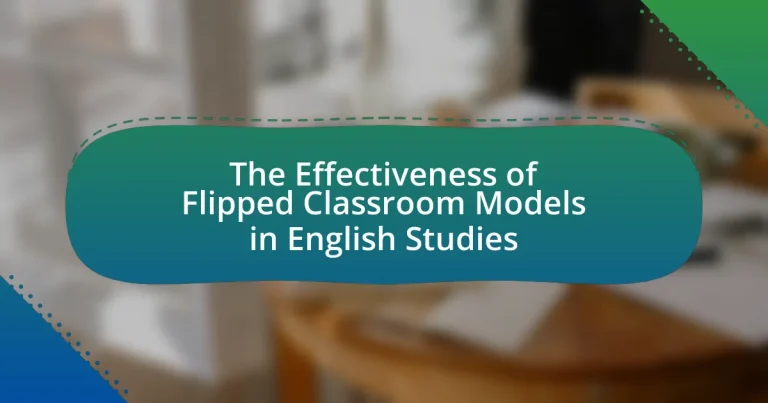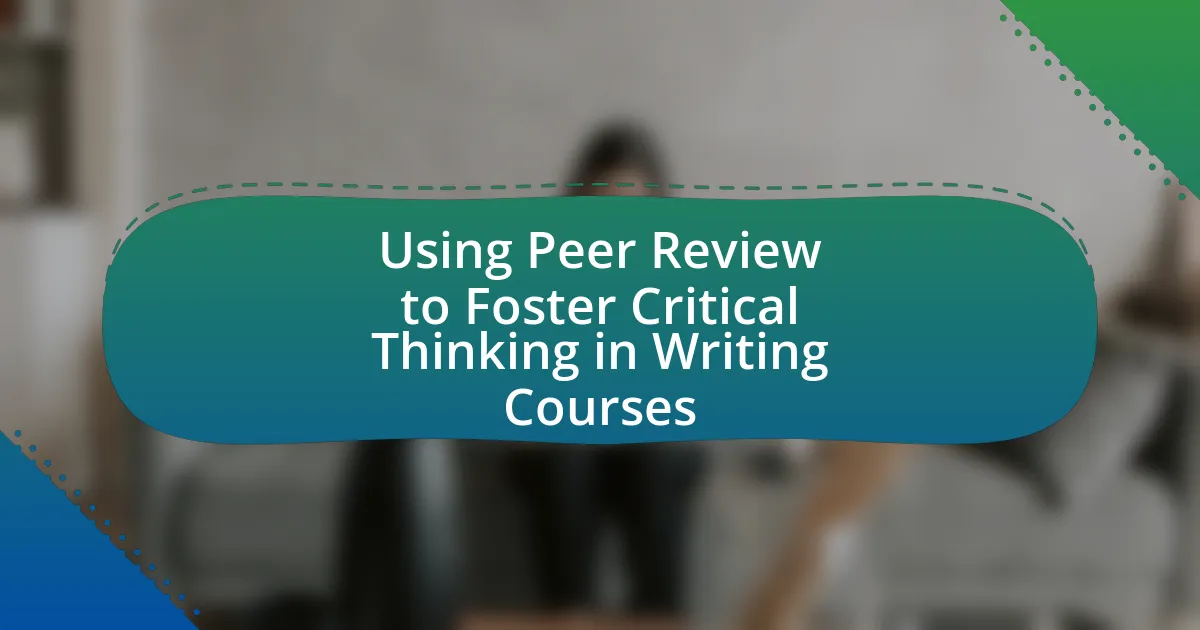Flipped classroom models in English studies represent an innovative instructional strategy that reverses traditional teaching methods by allowing students to engage with content outside of class, such as through video lectures, while dedicating in-class time to interactive activities and discussions. This approach has been shown to enhance student engagement, improve academic performance, and foster deeper understanding of the material, as evidenced by various studies. Key characteristics of flipped classrooms include active learning, personalized instruction, and the application of constructivist learning theories, which emphasize the importance of student participation and collaboration. Despite challenges such as student resistance and technological barriers, the effectiveness of flipped classroom models continues to gain recognition in English studies, leading to increased adoption and positive learning outcomes.

What are Flipped Classroom Models in English Studies?
Flipped classroom models in English studies are instructional strategies where traditional lecture and homework elements are reversed. In this model, students engage with instructional content, such as video lectures or reading materials, outside of class, allowing in-class time to be dedicated to interactive activities, discussions, and collaborative projects. Research indicates that this approach enhances student engagement and improves learning outcomes by fostering active participation and deeper understanding of the material. For instance, a study by Bergmann and Sams (2012) demonstrated that students in flipped classrooms showed higher academic performance compared to those in traditional settings, highlighting the effectiveness of this model in English studies.
How do Flipped Classroom Models differ from traditional teaching methods?
Flipped Classroom Models differ from traditional teaching methods primarily in the structure of learning activities, where students engage with instructional content at home and apply that knowledge in the classroom. In traditional methods, direct instruction occurs in class, followed by homework assignments. Research indicates that flipped classrooms enhance student engagement and understanding, as evidenced by a study published in the Journal of Educational Psychology, which found that students in flipped classrooms scored significantly higher on assessments compared to those in traditional settings. This model promotes active learning and allows for more personalized teacher-student interactions during class time.
What are the key characteristics of Flipped Classroom Models?
Flipped Classroom Models are characterized by the inversion of traditional teaching methods, where direct instruction occurs outside the classroom, typically through video lectures, while in-class time is dedicated to interactive activities. This model promotes active learning, allowing students to engage in discussions, problem-solving, and collaborative projects during class, which enhances comprehension and retention of material. Research indicates that this approach can lead to improved student performance and satisfaction, as it fosters a more personalized learning environment and encourages self-directed learning.
Why is the Flipped Classroom approach gaining popularity in English Studies?
The Flipped Classroom approach is gaining popularity in English Studies because it enhances student engagement and promotes active learning. This model allows students to access instructional content at home, freeing up classroom time for interactive activities such as discussions, collaborative projects, and personalized feedback. Research indicates that this method leads to improved academic performance; for instance, a study published in the “Journal of Educational Psychology” found that students in flipped classrooms scored significantly higher on assessments compared to those in traditional settings. Additionally, the approach caters to diverse learning styles, enabling students to learn at their own pace, which further contributes to its growing adoption in English Studies.
What are the theoretical foundations of Flipped Classroom Models?
The theoretical foundations of Flipped Classroom Models are primarily rooted in constructivist learning theories, which emphasize active learning and student engagement. Constructivism posits that learners construct knowledge through experiences and reflections, aligning with the Flipped Classroom’s approach of engaging students with content outside of class and applying that knowledge during in-class activities. Additionally, the model draws on principles of experiential learning, as proposed by David Kolb, which highlight the importance of hands-on experiences in the learning process. Research indicates that this model enhances student motivation and academic performance by fostering a more interactive and collaborative learning environment, as evidenced by studies such as those conducted by Bishop and Verleger (2013), which demonstrate improved learning outcomes in various educational settings.
How does constructivist theory support the Flipped Classroom approach?
Constructivist theory supports the Flipped Classroom approach by emphasizing active learning and student engagement. In a Flipped Classroom, students first encounter new material at home, allowing them to engage with content at their own pace, which aligns with the constructivist principle that learners construct knowledge through experience. This method encourages students to apply concepts during in-class activities, fostering deeper understanding through collaboration and discussion, which is a core tenet of constructivism. Research by Bergmann and Sams, who pioneered the Flipped Classroom model, indicates that this approach enhances student learning outcomes by promoting critical thinking and problem-solving skills, validating the effectiveness of integrating constructivist principles into classroom practices.
What role does active learning play in Flipped Classroom Models?
Active learning is central to Flipped Classroom Models as it transforms the traditional learning environment into one that emphasizes student engagement and participation. In these models, students first encounter new content outside of class, typically through videos or readings, which allows class time to be dedicated to interactive activities such as discussions, problem-solving, and collaborative projects. Research indicates that this approach enhances comprehension and retention of material, as students apply concepts in real-time with peer and instructor support. A study by Bishop and Verleger (2013) highlights that active learning strategies in flipped classrooms lead to improved academic performance and greater student satisfaction compared to traditional teaching methods.
What are the potential benefits of Flipped Classroom Models in English Studies?
Flipped Classroom Models in English Studies enhance student engagement and improve learning outcomes. This model allows students to access instructional content at home, freeing up classroom time for interactive activities that promote critical thinking and collaboration. Research indicates that students in flipped classrooms often demonstrate higher academic performance, as evidenced by a study published in the “Journal of Educational Technology & Society,” which found that 70% of students reported increased motivation and understanding of the material. Additionally, the model supports differentiated learning, enabling educators to tailor activities to meet diverse student needs, thereby fostering a more inclusive learning environment.
How do these models enhance student engagement and motivation?
Flipped classroom models enhance student engagement and motivation by promoting active learning and personalized instruction. These models shift traditional lecture content to outside the classroom, allowing students to engage with materials at their own pace, which fosters a sense of ownership over their learning process. Research indicates that students in flipped classrooms report higher levels of engagement due to increased interaction with peers and instructors during in-class activities, as evidenced by a study published in the Journal of Educational Technology & Society, which found that 70% of students felt more motivated to learn in a flipped environment compared to traditional settings. This active participation and collaborative learning environment significantly contribute to improved motivation and engagement among students.
What impact do Flipped Classroom Models have on student performance in English?
Flipped Classroom Models positively impact student performance in English by enhancing engagement and comprehension. Research indicates that students in flipped classrooms often demonstrate improved academic outcomes, as they benefit from active learning strategies and personalized instruction. A study by Bergmann and Sams (2012) found that students in flipped classrooms showed a 20% increase in test scores compared to traditional teaching methods, highlighting the effectiveness of this approach in fostering better understanding and retention of English language concepts.
What challenges are associated with implementing Flipped Classroom Models?
Implementing Flipped Classroom Models presents several challenges, including student resistance, technological barriers, and the need for significant teacher preparation. Student resistance often arises from a lack of familiarity with the model, as many learners are accustomed to traditional teaching methods. Technological barriers can include inadequate access to devices or reliable internet, which hinders students’ ability to engage with pre-class materials. Additionally, teachers must invest time in redesigning their lesson plans and developing effective instructional videos, which can be a daunting task without proper training or resources. These challenges can impede the successful adoption of Flipped Classroom Models in educational settings.
What technological barriers might educators face?
Educators may face several technological barriers, including inadequate access to reliable internet, insufficient training on digital tools, and a lack of appropriate hardware. In many regions, especially rural or low-income areas, internet connectivity can be inconsistent, hindering the implementation of flipped classroom models that rely on online resources. Additionally, educators often report feeling unprepared to effectively use technology in their teaching due to limited professional development opportunities, which can impede their ability to engage students in a digital learning environment. Furthermore, the absence of necessary devices, such as computers or tablets, can restrict both educators and students from fully participating in technology-enhanced learning experiences.
How can teachers address student resistance to this model?
Teachers can address student resistance to the flipped classroom model by actively engaging students in the learning process and providing clear expectations. Research indicates that when teachers incorporate student feedback and adapt their teaching strategies accordingly, students are more likely to embrace the model. For example, a study by Bergmann and Sams (2012) highlights that involving students in discussions about their learning preferences can reduce resistance and increase motivation. Additionally, offering support through resources and guidance helps students feel more comfortable with the model, leading to improved acceptance and participation.
How can educators effectively implement Flipped Classroom Models in English Studies?
Educators can effectively implement Flipped Classroom Models in English Studies by assigning pre-class activities such as video lectures or readings that introduce key concepts. This approach allows students to engage with the material at their own pace, fostering a deeper understanding before class discussions. Research indicates that students in flipped classrooms often demonstrate improved academic performance and engagement levels, as evidenced by a study published in the “Journal of Educational Psychology,” which found that students in flipped environments scored significantly higher on assessments compared to traditional settings. Additionally, educators should facilitate active learning during class time through collaborative activities, discussions, and hands-on projects that reinforce the pre-class content, thereby enhancing critical thinking and communication skills.
What strategies can teachers use to create engaging pre-class materials?
Teachers can create engaging pre-class materials by incorporating multimedia resources, interactive elements, and real-world applications. Utilizing videos, podcasts, and infographics can cater to diverse learning styles and enhance student interest. Interactive quizzes and discussion prompts encourage active participation and critical thinking before class. Additionally, connecting materials to real-world scenarios makes the content relevant, increasing student motivation. Research indicates that students are more likely to engage with materials that are visually appealing and contextually meaningful, which supports the effectiveness of these strategies in a flipped classroom model.
How can in-class activities be structured to maximize learning outcomes?
In-class activities can be structured to maximize learning outcomes by incorporating collaborative learning, active engagement, and formative assessment techniques. Collaborative learning encourages students to work together, enhancing their understanding through peer interaction, which has been shown to improve retention rates by up to 50% (Johnson & Johnson, 2009). Active engagement strategies, such as problem-solving tasks and discussions, keep students involved and facilitate deeper learning, as evidenced by studies indicating that active learning can lead to a 1.5 times improvement in student performance compared to traditional lectures (Freeman et al., 2014). Additionally, implementing formative assessments during in-class activities allows instructors to gauge student understanding in real-time and adjust instruction accordingly, which has been linked to increased academic achievement (Black & Wiliam, 1998).
What are some best practices for assessing student learning in Flipped Classroom Models?
Best practices for assessing student learning in Flipped Classroom Models include using formative assessments, peer assessments, and reflective journals. Formative assessments, such as quizzes and polls, provide immediate feedback on student understanding and can be integrated into online platforms used for pre-class activities. Peer assessments encourage collaboration and critical thinking, allowing students to evaluate each other’s work, which enhances learning outcomes. Reflective journals enable students to articulate their learning experiences and self-assess their progress, fostering deeper engagement with the material. Research indicates that these methods not only improve student performance but also enhance motivation and accountability in the learning process.
How can formative assessments be integrated into the Flipped Classroom approach?
Formative assessments can be integrated into the Flipped Classroom approach by utilizing pre-class quizzes, in-class discussions, and feedback mechanisms that inform both teaching and learning. These assessments allow educators to gauge students’ understanding of the material presented in video lectures or readings before class, enabling targeted instruction during class time. Research indicates that formative assessments enhance student engagement and learning outcomes; for instance, a study by Black and Wiliam (1998) found that effective formative assessment practices can lead to significant improvements in student performance. By incorporating these assessments, educators can create a responsive learning environment that adapts to students’ needs, ultimately enhancing the effectiveness of the Flipped Classroom model in English studies.
What tools can educators use to evaluate student progress effectively?
Educators can use formative assessments, digital portfolios, and learning management systems (LMS) to evaluate student progress effectively. Formative assessments, such as quizzes and peer reviews, provide immediate feedback on student understanding and can be adjusted to meet learning needs. Digital portfolios allow students to showcase their work over time, demonstrating growth and mastery of skills. Learning management systems, like Google Classroom or Canvas, facilitate tracking of assignments, grades, and student engagement, enabling educators to analyze progress through data analytics. These tools collectively enhance the evaluation process by providing diverse insights into student learning outcomes.
What insights can be drawn from case studies of Flipped Classroom Models in English Studies?
Case studies of Flipped Classroom Models in English Studies reveal that these models enhance student engagement and improve learning outcomes. Research indicates that students in flipped classrooms often demonstrate higher levels of participation and motivation, as they engage with instructional content at home and apply their knowledge in collaborative settings during class. For instance, a study by Bergmann and Sams (2012) found that students in a flipped English classroom showed a 20% increase in test scores compared to traditional teaching methods. Additionally, case studies highlight that the model fosters critical thinking and communication skills, as students are encouraged to discuss and analyze texts in a more interactive environment. Overall, the evidence suggests that Flipped Classroom Models can significantly benefit English Studies by promoting active learning and deeper comprehension.
What successful examples exist of Flipped Classroom implementation in English courses?
Successful examples of Flipped Classroom implementation in English courses include the University of Colorado Boulder and the University of Texas at Austin. At the University of Colorado Boulder, instructors reported increased student engagement and improved writing skills after flipping their English composition courses, where students watched lecture videos at home and participated in interactive activities during class. Similarly, the University of Texas at Austin utilized a flipped model in their English courses, leading to higher student performance on assessments and greater satisfaction with the learning experience, as evidenced by a study published in the Journal of Educational Technology & Society, which highlighted the positive impact of this approach on student outcomes.
What lessons can be learned from challenges faced in these case studies?
Challenges faced in case studies of flipped classroom models in English studies highlight the importance of adaptability and student engagement. Specifically, educators learned that flexibility in teaching methods is crucial to accommodate diverse learning styles and technological access. For instance, studies indicate that students may struggle with self-directed learning, necessitating structured guidance and resources to enhance their learning experience. Furthermore, effective communication between instructors and students emerged as a key factor in overcoming initial resistance to this model, as evidenced by improved student performance metrics when feedback mechanisms were established. These insights underscore the need for continuous assessment and refinement of teaching strategies to maximize the effectiveness of flipped classrooms in English studies.
What practical tips can educators follow to enhance the effectiveness of Flipped Classroom Models?
Educators can enhance the effectiveness of Flipped Classroom Models by incorporating structured pre-class activities, such as video lectures or reading assignments, that align with in-class discussions. This approach ensures that students come prepared, facilitating deeper engagement during class time. Research indicates that when students are actively involved in their learning process, retention rates improve significantly; for instance, a study by Bishop and Verleger (2013) found that students in flipped classrooms performed better on assessments compared to traditional settings. Additionally, providing clear guidelines and expectations for both pre-class and in-class activities helps maintain accountability and focus, further optimizing the learning experience.




